Screenings in Memory of Matsumoto Toshio
All films Director: Matsumoto Toshio Source: Image Forum except Ginrin Programming: Markus Nornes
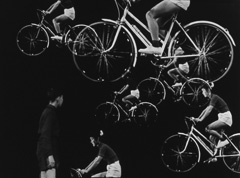 YIDFF 2017 Opening Films
YIDFF 2017 Opening Films
Ginrin
(Bicycle in Dreams)- JAPAN / 1955 / No Dialogue / Color / 35mm / 10 min
Script: Matsumoto Toshio, Kitadai Shozo, Yamaguchi Katsuhiro
Photography: Araki Shuzaburo
Art Directors: Kitadai Shozo, Yamaguchi Katsuhiro
Music: Takemitsu Toru, Suzuki Hiroyoshi
Special Effects: Tsuburaya Eiji
Production Company: Shin Riken Eiga
Source: National Film Center; The National Museum of Modern Art, Tokyo
A PR film for the Japan Bicycle Industry Association, Matsumoto’s memorable debut was born out of a collaboration with Jikken Kobo and Tsuburaya Eiji. It ushered in a new era in Japanese experimental film.
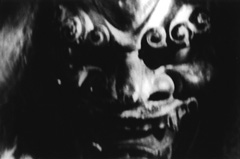 YIDFF 2017 Opening Films
YIDFF 2017 Opening Films
Nishijin
(Nishijin)- JAPAN / 1961 / Japanese / B&W / 35mm / 27 min
Script: Sekine Hiroshi, Matsumoto Toshio
Photography: Miyajima Yoshio
Producer: Asai Eiichi
Produced by: Kyoto Society for Viewing Documentary Cinema, “Nishijin” Executive Production Committee
Taking the district of Nishijin in Kyoto as its subject, this masterpiece of avant-garde documentary film dared to capture onscreen the contradictions that arose as the Anpo toso (the struggle against the U.S.-Japan security treaty) entered into everyday life.
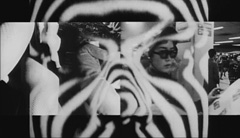 YIDFF 2017 Opening Films
YIDFF 2017 Opening Films
For My Crushed Right Eye
(Tsuburekakatta migime no tame ni)- JAPAN / 1968 / No Dialogue / Color / 16mm for three projectors / 13 min
Photography: Suzuki Tatsuo
Music: Akiyama Kuniharu
Producer: Kudo Mitsuru
A performative multi-projector work that seeks to pluralistically express the chaotic state of an unsettled period of time from the perspectives of hippies, gay people, the student movement, and the Kwon Hyi-ro Incident, etc.
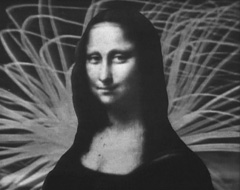 Mona Lisa
Mona Lisa
- JAPAN / 1973 / No Dialogue / Color / 16mm / 3 min
A pioneering work of video art that seeks to dislocate the obsolete image of the Mona Lisa by constructing a video synthesizer called “Scanimate.”
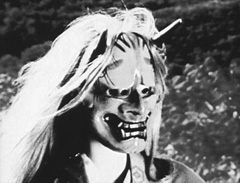 Atman
Atman
- JAPAN / 1975 / No Dialogue / Color / 16mm / 11 min
Music: Ichiyanagi Toshi
Five types of shot from roughly 500 camera positions in stop motion with differing exposures and color tones, then shot again, going through roughly 15,000 frames of animation. A quintessential work of Matsumoto’s experimental film. By foregrounding the process by which the artwork’s movement is produced, Matsumoto investigates the technology of cinema.
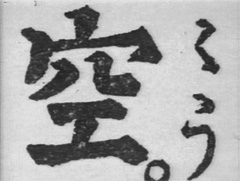 Everything Visible Is Empty / Shiki soku ze ku
Everything Visible Is Empty / Shiki soku ze ku
- JAPAN / 1975 / No Dialogue / Color / 16mm / 8 min
Music: Ichiyanagi Toshi
The text of the Mahayana Buddhist Heart Sutra is repeated five times, interspersed with ink drawings about the steps towards obtaining Nirvana. We experience the world of the Heart Sutra through rhythm.
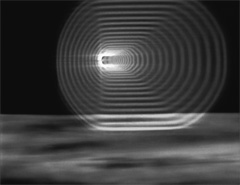 White Hole
White Hole
- JAPAN / 1979 / No Dialogue / Color / 16mm / 7 min
Music: Yuasa Joji
Using a Scanimate, this film expresses the sensation of being sucked into outer space.
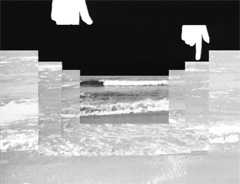 Relation
Relation
- JAPAN / 1982 / No Dialogue / Color / 16mm / 10 min
Music: Inagaki Takashi
In the early 1980s, Matsumoto put much of his energy into making works, such as this one, that focus on the rearrangement and shifting of the cinematic relationship between space and time.
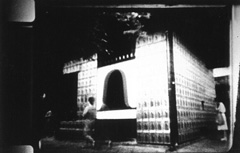 Sway
Sway
- JAPAN / 1985 / No Dialogue / Color / 16mm / 8 min
Music: Inagaki Takashi
By laying bare the materiality of film, this work takes on an inquiry into the function of the frame in giving a feeling of reality to space-time recorded on film.
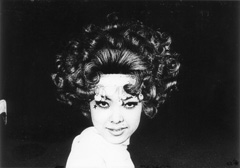 Funeral Parade of Roses
Funeral Parade of Roses
(Bara no soretsu)- JAPAN / 1969 / Japanese / B&W / 35mm / 104 min
Script: Matsumoto Toshio
Photography: Suzuki Tatsuo
Music: Yuasa Joji
Art Director: Asakura Setsu
Editing: Iwasa Hisaya
Sound: Katayama Mikio
Producer: Kudo Mitsuru
Cast: Peter, Tsuchiya Yoshio, Ogasawara Osamu, Azuma Emiko, Komatsu Hosei
Production Companies: Matsumoto Productions, Art Theatre Guild
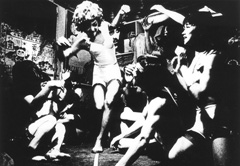 Based on Sophocles’ Greek tragedy Oedipus Rex, Matsumoto’s first narrative film attempts a reversal of phallicism in Freudian psychoanalysis by featuring gay protagonists. The critique of the dualism between the one recording and the one being recorded—a consistent motif of Matsumoto’s—is intertwined with an embedded story structure by going back and forth between documentary and fiction, and employing montage of cross-sections of space-time; in which a record of contemporary Shinjuku is entangled with the chaotic tragic comedy that Matsumoto brings into existence.
Based on Sophocles’ Greek tragedy Oedipus Rex, Matsumoto’s first narrative film attempts a reversal of phallicism in Freudian psychoanalysis by featuring gay protagonists. The critique of the dualism between the one recording and the one being recorded—a consistent motif of Matsumoto’s—is intertwined with an embedded story structure by going back and forth between documentary and fiction, and employing montage of cross-sections of space-time; in which a record of contemporary Shinjuku is entangled with the chaotic tragic comedy that Matsumoto brings into existence.
 Matsumoto Toshio
Matsumoto Toshio
Born in 1932. Matsumoto Toshio was hired in 1955 by Shin Riken Eiga, where he directed his first film, Bicycle in Dreams. He became freelance in 1958. While continuing to release documentaries such as U.S.-Japan Security Treaty (1959) and Long White Line of Record (1960), which boldly attempted new feats within the framework of PR films, he also published A Theory of Avant-Garde Documentary as a new methodology that incorporated criticism of previous generations, developing theoretical movements full of vim and vigor. In the latter half of the 1960s, Matsumoto became engrossed in epic works of intermedia, advancing into narrative film as well. He directed Funeral Parade of Roses (1969) and Demons (1971) at ATG. During this period Matsumoto would continue to release experimental films such as Metastasis (1971) and Atman (1975). His books include The Discovery of the Image (1963) and Itsudatsu no eizo (2013). Matsumoto passed away in 2017.
Epitaph for Matsumoto Toshio
Matsumoto Toshio has passed away. Matsumoto Toshio, who not only broke new ground in postwar documentary theory and practice, but also spearheaded movements in Japanese experimental film and video art, and even left a sizable mark on the world of narrative film. Above all, he indisputably set many of the standards for Japanese documentary film, and furthermore Japanese film as a whole, from the end of the 1950s on. In 1957 the young Matsumoto threw down the gauntlet in the bulletin of the Kyoiku eiga sakka kyokai (Association of Education Filmmakers) with the publication of Sakka no shutai to iu koto (On the Filmmaker’s Subject; fortunately republished in Matsumoto Toshio chosaku shusei I), an important manifesto that incited a “new cinema” in Japan, similar to how Jonas Mekas’ First Statement of the New American Cinema Group (1961) and Alexander Kluge’s Oberhausen Manifesto (1962) inspired similar movements in their respective countries. It was Matsumoto’s raising of the issue in this essay that gave filmmakers both the opportunity to assertively take responsibility for their wartime role, as well as a way to explore pluralistic methods that represented a break from the older generation in their reinvention of methodologies of documentation.
Recently there has been a reappraisal of Matsumoto’s work, including the rediscovery of the once lost Bicycle in Dreams (1955) and Long White Line of Record (1960), the release of a DVD box set, some older writings re-published and new writings published for the first time, a new collaboration with young filmmakers titled Toro no ono (2009–2012), and a large-scale 2012 retrospective at the Kuma Museum of Art. This is largely due to his continuous stance to share his views with all generations that followed. We are extraordinarily fortunate to have been able to spend time with Matsumoto and his ideas. He left behind an enormous body of text for us. As the look and feel of cinema continues to become more amorphous, it is up to us now to face one another within the cross-sectional framework that we have been bequeathed. Our prayers go out to him.
